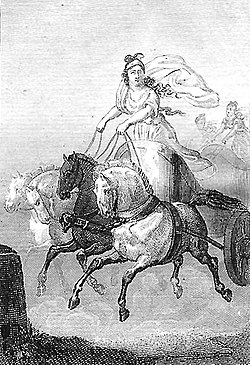Cynisca
Cynisca (/sɪˈnɪskə/; or Kyniska, Greek: Κυνίσκα; born c. 442 BC) was a wealthy Spartan princess. She is famous for being the first woman to win at the Olympic Games. She took part in the sport of chariot racing. Cynisca first entered the Olympics in 396 BC. There, she won first prize with a team of horses she had trained herself. In 392 BC, Cynisca entered her horses in the Olympics for a second time and was awarded another victory in the same event.[1]

Early life
changeCynisca was born around 442 BC in the ancient Greek city-state of Sparta. She was the daughter of the Eurypontid king Archidamus II. Her brother was Agesilaus II. He later became a king of Sparta. Because of her family's wealth, Cynisca was able to spend time developing her sporting skills and learning how to train horses for chariot racing. This allowed her to win at the Olympic games later. According to Pausanias, Cynisca wanted to win at the Olympic Games since she was young.[2]
Several sources from Xenophon and Plutarch tell how Cynisca's brother Agesilaus encouraged her to breed horses and compete in the games, when she was still young. His motivations for doing this have recently been debated. According to these ancient sources, Agesilaus saw success in chariot racing as a victory without merit. In other events a man's bravery and virtue were the decisive factors, acording to him. He believed that chariot racing only demonstrated wealth. This was because the owner of the horses was not directly involved. Both of these ancient authors suggested that Agesilaus wanted to show how the sport was unmanly and aristocratic by having a woman win. In reality, Cynisca's victories did not stop wealthy Spartans from engaging in the sport.[3][4] Several modern scholars, on the other hand, have theorized that Agesilaus' motivations were more practical. They suspect that he was simply using her victories and wealth to promote his own political career and gain public support through his association to her, rather than providing a moral lesson.[5] The evidence provided to support this theory is that Cynisca's two Olympic victories would have also brought fame to Agesilaus and to the wider Eurypontid house. Additionally, the establishment of Cynisca's hero-cult after her death could suggest that Agesilaus was still making use of his sister's fame even after she had died.[5]
Origin of the name
changeCynisca's name means "female puppy" in Ancient Greek. She was named after her grandfather Zeuxidamus, who was called Cyniscos.[6] It is possible that this name is derived from the hunting traditions of the Spartan elite, or her family's practice of raising hunting dogs.[7]
Olympic activities
changeWomen were not allowed to compete, or even watch most Olympic events. According to Pausanias, any woman found on the site had to be thrown off the rock of Typhaion.[8] This only applied to married women (gunaikes), the only exception was the priestess of Demeter.[9] Unmarried women were allowed as spectators. It seems that only one woman was ever found. She was named Kallipateira. She was a widow, who disguised as the person training her son. She was found when she jumped into the air when her son won.[10] She was spared the fate, but to avoid this happening again, all people competing, and the people training them had to be naked.
References
change- ↑ Welwei, Karl-Wilhelm (Bochum), "Cynisca", in: Brill's New Pauly, Antiquity volumes edited by: Hubert Cancik and, Helmuth Schneider, English Edition by: Christine F. Salazar, Classical Tradition volumes edited by: Manfred Landfester, English Edition by: Francis G. Gentry.
- ↑ Pausanias, Description of Greece, 3.8.1–3.
- ↑ Xenophon, Minor Works, Agesilaus 9.1 §6.
- ↑ Plutarch, Parallel Lives, Agesilaus 20.1
- ↑ 5.0 5.1 Millender, Ellen G., "Spartan Women" p. 500-525. In A Companion to Sparta,edited by Anton Powell, Vol. 1 of A Companion to Sparta. Hoboken, NJ: Wiley Blackwell, 2018.
- ↑ Herodotus, vi 7
- ↑ Kyle, Donald (2003). "The Only Woman in All Greece": Kyniska, Agesilaus, Alcibiades and Olympia". Journal of Sport History. 30: 183–203 – via JSTOR.
- ↑ Pausanias, V, 6, 7 and V, 13, 10
- ↑ Pausanias, VI, 20, 9.
- ↑ Pausanias, VI, 7, 2